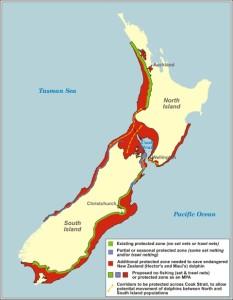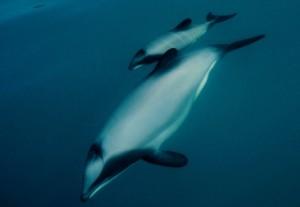Media Release: Whale and Dolphin Conservation
 Every year, between 110 and 150 New Zealand (Hector’s and Maui’s) dolphins die accidentally in fishermen’s nets. In recent decades, the population has plunged from 30,000 to only 7,200. The North Island subspecies of this dolphin, called Maui’s dolphin, has just 54 adults left.
Every year, between 110 and 150 New Zealand (Hector’s and Maui’s) dolphins die accidentally in fishermen’s nets. In recent decades, the population has plunged from 30,000 to only 7,200. The North Island subspecies of this dolphin, called Maui’s dolphin, has just 54 adults left.
A just-released independent survey, commissioned by Whale and Dolphin Conservation (WDC), has discovered that 80% of New Zealanders not only want protection measures, they are willing to help pay for them.
The NZ Dept. of Conservation (DOC) has created several marine reserves to protect the dolphins but they cover only a tiny percentage of the dolphins’ habitat.
Erich Hoyt, WDC Research Fellow and a lead author on the overall study says: “If ever a government had a mandate to take strong measures to protect a species, this is it.”
The survey found that:
• 63% of respondents would pay more for their fish to reduce the numbers of dolphins killed by fishing activities.
• 57% support the establishment of a large marine protected area covering the areas out to 100m depth where the dolphins live, removing commercial set netting, trawl fishing as well as recreational set netting from this area (See map).
• 53% would support a ‘dolphin protection tax’ as an annual levy on every tax return.
The study, using the survey data, determined that NZ residents, would be willing to pay NZ $355,000 to protect a dolphin. The 110-150 dolphins dying in nets every year represents an estimated NZ $46 million annual loss to the people of New Zealand ($355,000 x 130 = $46 million).
Economist Tristan Knowles, from Economists at Large who collaborated with WDC on the study, says: “This ‘cost’ is not surprising considering the dolphins are an endemic species to NZ waters, have low numbers, and are well known to the public.”

The researchers recognize that the study has implications for both the fishing and the tourism sectors of the economy. Mike Bossley, Australasian science director for Whale and Dolphin Conservation (WDC) says: “With dolphins dying every week in nets, it can’t be good for the short- or long-term ‘100% pure, clean and green’ image of New Zealand to have to deal with so many carcasses of a beautiful dolphin found nowhere else in the world. It’s time to take serious steps before it’s too late.”
The study authors recognize that it will take time to work out a plan to pay for the conservation measures, but the wishes of the public are clearly there.
Details of the study are to be presented in a poster session at the Society for Marine Mammalogy Biennial Conference to be held in Dunedin, New Zealand, 9-13 December 2013. This is the world’s biggest meeting of whale, dolphin and other marine mammal experts. The overall conference theme is how good science can inform conservation policy decisions. Key conference speakers are focusing on the New Zealand dolphin crisis. A specialized workshop on NZ dolphins is being held in Akaroa the week after the conference. International experts on dolphin conservation and policy makers will discuss practical options to save New Zealand dolphins.
The independent survey of 1,000 New Zealand residents was conducted in November, based on questions designed by the study authors, Erich Hoyt, Gemma McGrath, Mike Bossley from WDC and Tristan Knowles from Economists at Large. The survey results, presented in summary form in a scientific poster, are now being folded into a more detailed report on the study.

